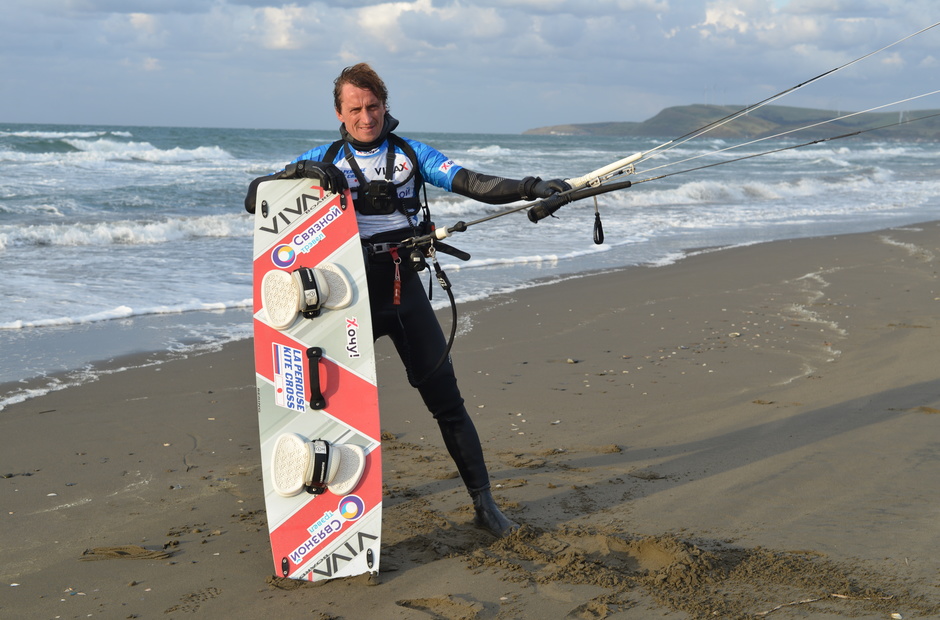In October 2019, Evgeny Novozheev, aka Jackson, set a world record by crossing the La Perouse Strait on a kiteboard from Russia to Japan. The total length of the route was 54 km and time - 2:56. It doesn't sound so terrible if you don't think about 4 meter waves, unpredictability of wind, loss of connection with escort and a lot of other dangers. Although no, it even sounds scary.
By the way, Eugene himself comes from Solnechnogorsk near Moscow, where the sea is not even close. What did not prevent him from becoming a four-time world champion in kiteboarding, in 2011 to make a solo crossing of the Bering Strait (7 hours 52 minutes and 175 km), open a kite school in Mauritius, take part in the shooting of several films.
Q: Why La Perouse?
This place was marked from the beginning, just after crossing the Bering Strait. We were in Alaska, we did not understand what had happened, but we were already looking at the map and making further plans. Our second neighbors on the other side are Japan, so the choice is obvious. 2 years after the Bering Strait, in the 13th year, I was there again: helping with the global walrus project. 65 people from all over the world were going to swim through the Strait. For them, the Bering is like Everest, a dream, a peak of experience. And since I was there 2 years before them, I was one of the few who had seen the entire strait and knew something about it.
I was taken as a guide, I was consulted, and I ended up on an escort ship. For us, it was a cool excuse to be there again: during our transition, the GoPro camera attached to my head immediately flew away. And we had to do the backstage.
I helped them, by the way, very coolly to cope with the currents, I even received a state award for it. Swimmers in general their own forces row. there, in the water, they are even harder.
And so the head of that project, Oleg Dokuchaev, former colonel, invited us to Vladivostok for the premiere of the film shot there.
It so happens that he now heads the Primorye Olympic Committee. And then there is the Olympics in Japan, kiteboarding has been an Olympic sport since 2024. That is, it will be presented already in France. Plus, there, in Vladivostok, was my Bering Strait accomplice. He was crossing La Perouse in September, by the way, but something didn't work out.
Q: But at the same time, we were blocked for four years at the Olympics...
We didn't know about it at the time. We came to the Russian Olympic Committee with our idea, they say: Yes, everything «is cool. But everyone is nervous there, so in the end it turned out that they are ready to support, but now they can not do anything at all. It didn't stop us.
We're kind of doing it all for the idea: the kite is finally at Olympics, and we've been doing it for so long.
That's really the only idea we've had. And the WADA decision came up in early December. It's a shame, but what to do.
We have prepared for this crossing in a month: agreed with the border guards, and this is a whole story. The main thing is not even the transition itself, but the preparation for it.
Q: In preparation, do you memorize all currents?
Neither about La Perouse, nor about any other strait, hardly anybody will tell you anything, because hardly anybody went there. It's not the most navigable place, especially for sailboats. And nobody understands how or what works there.
But in any case, you have to try to find out as much as possible. Local guys help first, of course. At least to understand in general, under what direction of a wind to go. Because if you look at the forecast, blows from all sides, everything is constantly changing, and what is the most favorable wind - it is not clear at all.
Anyway, it was decided that we need the Northwest.
We were very much helped by the famous typhoon Hagibis, which blew half of Japan [typhoon category 5, maximum wind: 260 km/h]. The strongest in the last 60 years. We got right under it: it was really his tails and we were very lucky with it.
I know cyclones well from Mauritius. It's a real hurricane, but I have a rough idea of how it works, how it moves, how it looks from the inside and how its tails look.
Q: Won't the wind inside the typhoon be very uneven, gusty?
Of course, it's just gusts, but the wind is very stable. It can't end up like this, which is the most important thing. For those places it is typical in general: before dinner it is met on the one hand, then all has turned off to zero and blown on the other hand.
And the wind from under the typhoon is different. The typhoon goes, the cyclone moves, spins, goes to the Pacific Ocean. And those tails of it won't let the wind just suddenly evaporate. It still needs some time to slip to zero.
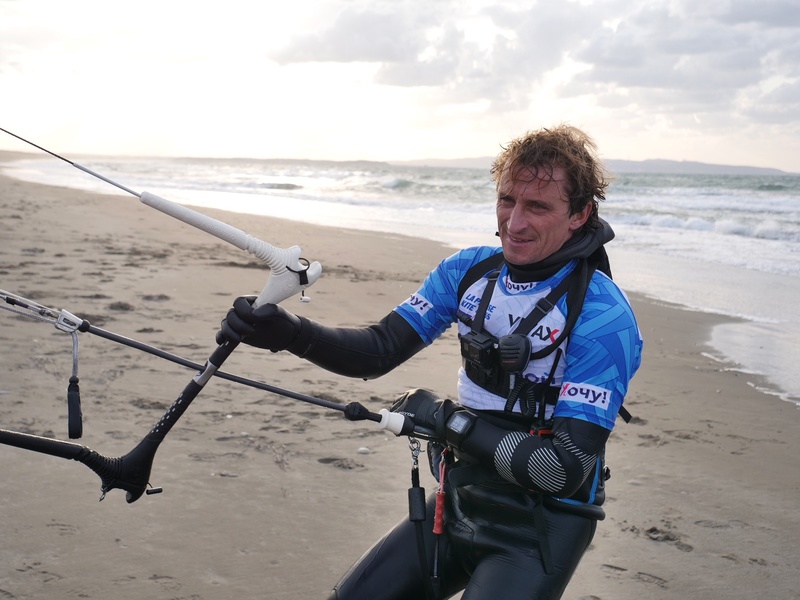
Q: You had a boat with you for emergencies, right?
Yes, there was a boat. It was planned that it would go nearby. I organized the connection: good walkie-talkies, waterproof headset. We were hoping for a full suite: all the time we would be in touch, communicating. But it didn't work out that way.
the boat and I were always apart. The problem was, they couldn't follow me as I wanted.
The Japanese strongly insisted that we give them a clear route for the boat. They - like everybody else - didn't quite understand how the kite was moving, they thought that it could go exactly the way it was going to.
The route was connected to their networks. As soon as you cross the border - well, in 2 kilometers from the border (there are neutral waters) - everything at once is dotted with nets: huge gardens. And our route should have been built around them, and even coordinated with their owners, directors of these Japanese fishing collective and state farms. That is there was not even some centralized structure with which it would be possible to coordinate everything, border guards simply switched arrows on each other.
Even the day before we started, we had no agreement with Japan: they wanted a route with the coordinates of the turning points of the boat that surrounded the network. I sat there and did not know where I would get them.
We had a network map from somewhere, which wasn't given to us by them. And I had to set these points, how the boat would turn, send them a million numbers of coordinates. This curved route arranged for them in the end.
Our boat captain first said: «Come on, what nets, we were all there, all saw. Come and go. But he must have been scared at the last minute that his visa might be a problem. And he was very tense. At one point, the route became more priority for him than I was. And I'm not riding a kite around the nets! I will go straight anyway, because I know that nothing terrible will happen, kite is a maneuverable thing, I will jump or just move if necessary.

And he ended up going exactly the same route.
Q: How'd you get all twisted up? Hardly looked at GPS all the time.
I had a navigator in my bag, it's mandatory. But it was a good thing there: the finish point was marked originally. At first we planned to finish at Cape Soya, where it would be ideal to go, but there were too many networks and we were immediately closed to approach there. So the route was 13 more kilometers: the shortest route was 44 kilometers, but we got 57.
As a place of finish we have approved a beach where supposedly no networks. I agreed, but I understood that if something went wrong, I'd still go out where I went, and whatever happens. This finish point was close to the airport, even on Google maps you can see the runway nearby.
And so, when I could see the shore, I was looking at the planes. It was clear where they landed, and in principle, GPS should not be used anymore.
Q: Did the wind fail in the end?
Already on the Japanese side he started to acidify, which I was afraid of. There was a sharp gust, a squally wind. That is, you go quietly, then in kite as it will give you, as somewhere in Moscow region! But I was sure that I'd cut myself out at this rate.

And there was a very strong sense of lateral flow. It was in the wind and I knew that I was cutting, I was going very hard in the wind, this should have created a good margin of height. And that's not happening. I felt that I was very much dragged by the current and dragged to all the same cape of Soy. So everything was a little on edge.
Q: So you've been cutting out against the wind all three hours? Your leg didn't fall off at the end?
Yeah, one tack all the time. My leg fell off... I mean, you still have to jump, and the pool was normal. Really was more powerful than Bering's.
I don't know why it rocked so hard there, but the waves were 5'4". I like to exaggerate, of course, but that's fair. I was surprised, even a little bit.
And these lambs are still. This huge roller rolls on you, and if there are still lambs on top, you just crash into it and fly. And you have to practice every kicker like that, and if you miss it, you fall.
Q: And when you fall, you're blown back in the wind...
Doesn't take much. Even though I lost a board once. But I found it very quickly. Usually in such a case, it turns on some kind of afterburning.
But I knew at the start that the conditions are unpredictable, it is not clear what will happen next, whether the wind will slip. Because of this, at the beginning, I flooded very quickly, although I understood that the forces must be calculated. And after an hour, I felt that my strength was running out. But the fact that the wind would end was scarier.
Q: Did you do any physical training?
Yeah, I already knew what was waiting for me, thanks to Bering. After him, I walked for three more days and didn't bend over: it's all packed up. It's hard, but it's not just a ride on the beach. Cause in three hours of gurney riding, you won't even get tired. And here and stress influences, and one tack all to pass - it, consider, on one leg: here to sit down on it and to sit 3 hours.

Q: Have you been resting?
No, it's too strong for that. It was only when he got to the cape that it got easier. There is already the main thing not to approach the shore, because the wave is healthy, but to go upstream.
The boat, by the way, I didn't see the boat there or at the finish line. I didn't see it until five to ten minutes after I got ashore. Already hung out, walked there, looked, and only after that she appeared somewhere far away. The most interesting thing is that the walkie-talkies were good, but if the boat and I split up literally for a kilometer - nothing can be heard at all, one hissing. There's even a video of me on this radio saying: Can anyone «hear me? ... Actually, it's silent.
Once we crossed them, and I cursed at them: Well, you're kidding«, on the boat go, do something, try to at least just follow me . Then I drive away, I look at this boat - and there it is also like a shell winding from side to side. They've been there themselves on this boat, I'm sure. It's not very big, but still not maneuverable enough. But that's all I realized later.
Q: Was there a Bering escort?
No, just in the beginning. And there were boats there: six-foot kazanaks with a power 50. We thought they'd at least make it to the border with us. They can't cross it, there was no way to cross it with the Americans. They were just spinning at the temple: Come «on, guys, no boat will go out there - you have no idea what the Bering Strait is.
boats with us have only passed an hour, less than 20 km out of 100. Then they started saying that they were flooded. And there are two of them: one at the wheel, the other on a bucket, dredging.
It was useless to talk about it. I tried, but they said we'd «drown. I've already figured that out myself. So they turned around and left.
But the idea to go further without them is pure nonsense, of course.

Q: How does your family feel about such experiments?
Well with La Perouse everything was well organized, everyone - and I myself, to be honest - believed in the accompaniment.
As well as in the Bering, alone, I would not go any more, nor would I advise anybody. It's suicide.
Wind skis, that's all, no one would even find it, because there's no such technical possibility.
And here everything was clear, good boat nearby, sling 24 meters, kite big enough, anyway in sight they probably have and will not disappear. They'll probably come up with something. Although there was a moment when they also had a little panic on the ship: the captain is on his route, and the director Vlad Bykov had the attitude not to lose sight of me. And at some point they go so far away that they stop seeing the kite. And it's not even clear where to see if I'm alive there.
Q: What did you do first when you were on the beach?
Oh, that's a whole story. First, we had an agent there: a Russian guy who lives in Japan and receives ships. Without a ship's agent, no one can enter the port at all.
It's a different story for him. I negotiated with him for a month, calmed him down - he was very worried about his reputation to make everything go smoothly with Japan. First of all, of course, he was afraid for himself. At some point, he had already decided to jump out. I told him: «Sasha, calm down!»and he showed me a Bering movie. After that, he was a little excited, even the patriotism turned on, although he has lived in Japan all his life.
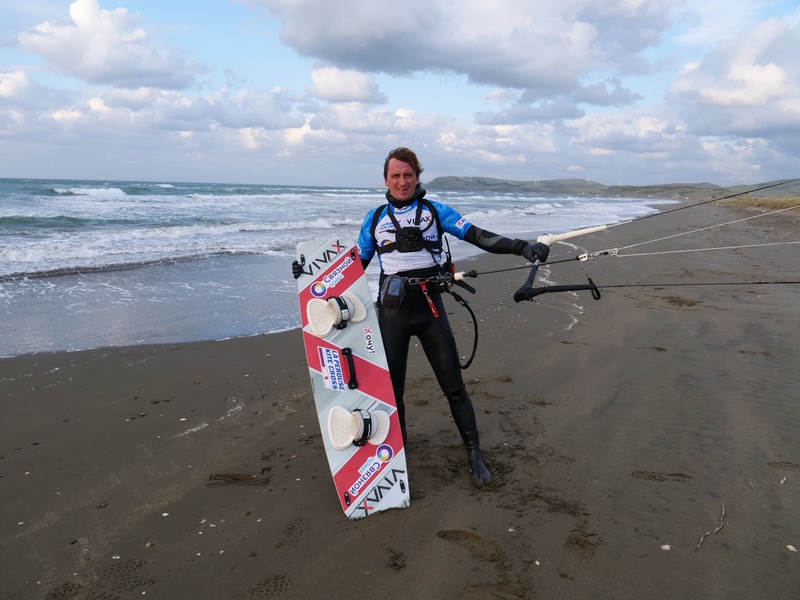
The finish line was agreed with him. And so I finish - tired, fucked up. And the agreement was that I didn't go ashore because it's outside the checkpoint and customs. That is, I have to go out in the waist to set a record, and then go back in the boat.
I missed 300 yards from the marked point. Of course, I went ashore, I fell asleep to breathe. I see some dude running towards me. Well, obviously not Japanese looks, I know it's him. And he's like, "Hey«, what's the finish line over there, 300 yards! And I say to him: Sasha, «fuck you... I'm tired. I»understand very well: even if the border guards come now, it will be like with the Americans.
The maximum they'll do is come out for a picture. Because this is an event that doesn't happen every day. No one's gonna cuff me or take me to jail.
And he's so tense, I tell him I'm leaving on a boat. And then he decided to support me, says: Customs «are on their way here, they know that you come here. I'll call them now, they're about 15 minutes away. Can you leave in 10 minutes at least?»
Actually I had a rest in 5 minutes and went to the boat, then we went to the port to make out. And naturally, everything was as I expected: all customs officers and journalists began to take pictures with me, no one bothered.
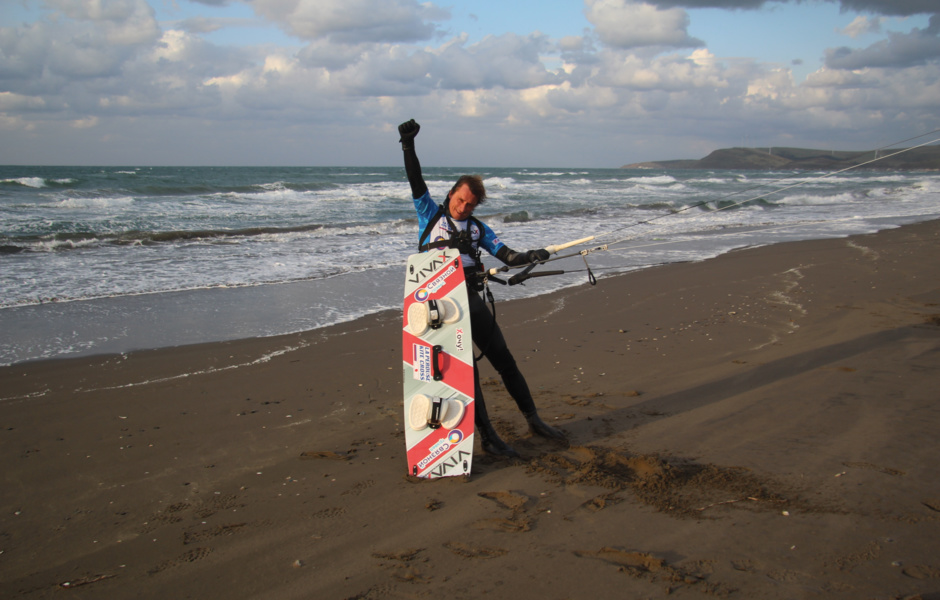
Q: How long have you been a kite skater, anyway?
С 2003. I started when I was 25. Four times I was champion of Russia, I did a lot of freestyle. But in 2010 I calmed down a bit, and the idea with Beringov came - that's the point to put. But I liked it so much that it was difficult to calm down.
And in the 13th year I was already in Mauritius seriously and for a long time, started waving riding, surfing, so the next stage was included, these waves. Then we made a TheYard «movie. A big wave» with Seva Shulgin in 2016.
Q: Is there anything else besides the kite? Have you tried yachting?
I'm already surfing more now.
Freestyle's not that tired anymore, but it's a little heavy. I am already all broken: how many ligaments have been torn and bones broken, and further - harder.
So it's time for young people to leave it all behind. Well, I got a good hold of the freestyle: still, for 9 years, this is all I did. I did not instruct anywhere during this period, only trained and competed. It's just that I had sponsors for the second year already and so I had only the wind in my head.
And yachting is the next stage! I like it very much, I am sure that I will try and fly there with my head.
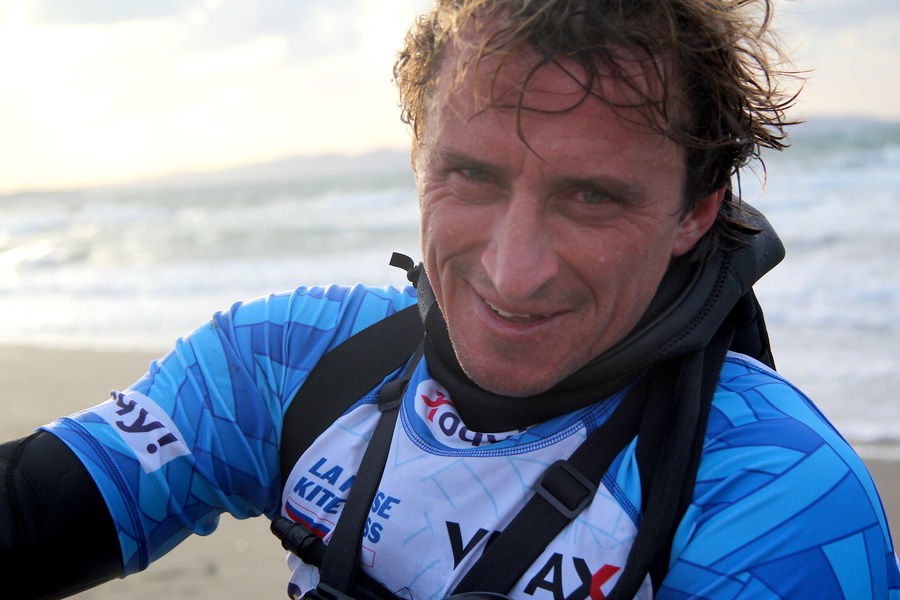
Q: Are there any more plans for the transitions, or is there enough for now?
Yes! But I'm not telling anybody about these plans yet. That's so cool! All this adventure, all the adrenaline, the preparation, the transition from one continent to another - it's all an unreal experience!

